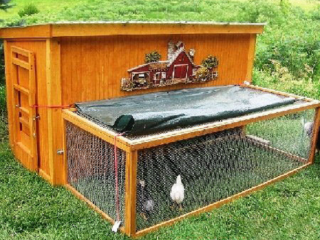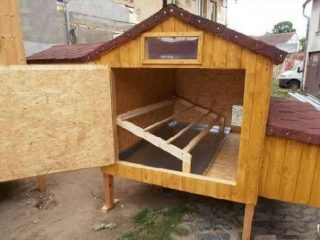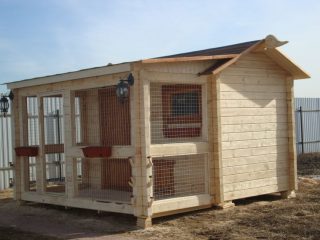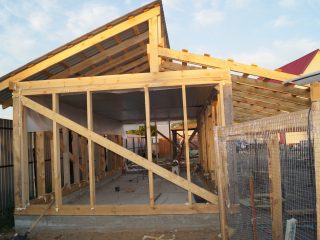Content
Chicken coop designed for winter keeping chickens must be insulated in a certain way. This will protect the bird from wind and cold. Due to the comfortable conditions, hens will lay many eggs. Such structures are easily constructed on their own. First, you should take care of installing high-quality lighting. It is important to ensure that the insulation of the chicken coop is comprehensive.
Features of insulation
During construction warm chicken coop with your own hands the correct material must be selected first. Subsequently, it will fit on the floor in the chicken coop, and be mounted on the walls.
Quite often, work on insulating the walls of the hen house is carried out using foam or sawdust. The roof is also covered with foam plates. In the case when a tree is chosen for the construction of a chicken coop, the insulation technology will not differ from the creation of an insulation layer in an ordinary wooden house. The work is carried out from inside the hen house.
When constructing the walls of the hen house, the following can be used:
- brick;
- aerated concrete;
- clay.
The choice of a method for insulating a chicken coop for the winter depends on such design parameters as the thickness of the walls and the climate in a particular region. During the construction of a chicken coop, you should be very careful about the structure of the roof. This is due to the fact that in the hen house in winter, warm air accumulates at the ceiling and can quickly leave the room if you do not take care of its retention. With a sufficiently thick and dense insulation, warm air masses will remain in the chicken coop for a long time.
The roof for the winter chicken coop is made of two layers. It is made of roofing material and roofing felt. Chips and sawdust are placed between them.
Foundation device
For a do-it-yourself winter chicken coop, the choice of a columnar foundation is more optimal. Its construction will not take much time. In addition, there is no need to wait for the solution to harden. Under the floor of the chicken coop, which is insulated with sawdust, thanks to the use of a columnar base, there will be a well-ventilated space. This will extend the life of the coop floor. In addition, this solution eliminates the appearance of rodents.
To create the foundation of the chicken coop, you will need to perform the following actions:
- First, the markup is done. It is made with pegs and whips. Stakes are installed around the entire perimeter of the building. Then they are connected with a rope. Now you can remove the top layer of soil.
- In the corners pits are dug out for supports. They will subsequently be fitted with base pipes. The pits are half a meter wide and 70 cm deep. Gravel and sand are poured into the bottom of each pit. Its height should be 10 cm.
- After completing the sand cushion, stones and bricks are laid in the pits. Now you can start pouring the concrete solution.
- Two more bricks are laid across the already laid bricks. This allows the foundation pipe to be raised to the desired level.
- The space between the supports of the chicken coop is covered with gravel.
- For the construction of the roof and walls, beams are installed on the base. Roofing material should be laid between the first row of beams and the foundation. It is necessary to mount 2 layers of this material.
When making a chicken coop from beams, you will need to insulate each crown with a special material. The walls of the building are usually erected to a height of 1.8 m.Then the following work should be performed:
- fix the ceiling beams;
- install the rafter system;
- to lay the roof of the chicken coop;
- build a ceiling.
Knowledge of these features of the work will allow you to insulate the roof quickly enough.
Floor insulation
Particular attention is paid to the floor of the chicken coop. Insulation for it must meet certain requirements. The best option is litter... It can be of different thickness. The litter is deep and shallow.
When raising birds in domesticated conditions, the first option is chosen. Its difference lies in the way heat is generated. Various processes of a chemical and biological nature are constantly taking place in it. This generates heat.
The temperature inside such a litter usually rises to +25 degrees. As a result of various processes, an acidic environment is formed, which significantly slows down the decomposition of chicken droppings. This circumstance is a significant advantage of deep litter.
Moss peat is often used for the bedding insulation of a chicken coop. This material perfectly absorbs moisture. Due to the use of moss peat, the pungent smell from chicken droppings is eliminated. In addition, litter is used as fertilizer in spring.
Another popular way to insulate the floor is to cover the surface with sawdust and wood chips. It is better if the mixture contains 2/3 sawdust and 1/3 shavings. It is better to choose sawdust from coniferous trees. They have pest control properties.
Due to the characteristics of the shavings, it is able to perfectly absorb water. Such material does not cake. To increase the moisture permeability index, peat is added to the initial mixture.
Another popular insulation material is straw chaff. It should have a length of 3 to 5 cm. Thanks to the use of such material, the floor can be well insulated.
Initially, a deep underlay for insulation is laid in a layer having a thickness of 20 cm. As it gets dirty, new material is poured in. Each subsequent layer is made with a height of 5 to 10 cm. From time to time, the litter should be loosened, reaching to the very bottom.
Wall insulation
To figure out how to insulate a chicken coop for the winter, a simple video instruction at the end of the article will help. To make the stay of the bird in the chicken coop as comfortable as possible, the walls of the building are best made of natural wood. Usually conifers are chosen for this. In regions with rather harsh climatic conditions, it is better to choose beams or logs. The log house will perfectly protect the chicken coop from heat loss.
For mild climates, you can prepare inch boards. To strengthen the walls, all cracks should be sealed with tow (a common method of insulation). Moss is often used for this purpose. From above, the insulation must be sewn up with slats. In this case, the hens will not peck the tow.
Outside, insulation is carried out with foam plates. To protect such insulation, flat slate or plastic is installed. Most often, boards are used to create walls. They are stuffed onto the frame from both sides. Frame chicken coop insulated quite simply.
Warming can also be carried out using sawdust. The material must be mixed with fluffy lime, and then laid in layers. Wall upholstery can be done with shingles. It is applied in a double layer. The shingle is nailed at a 45 degree angle.
Then the resulting layer is plastered. For this, clay with sawdust is used. It must be remembered that the minimum thickness of the applied layer is 3 cm. After the walls have dried, each crack that appears must be covered with a mixture of sand and clay.
Insulation of openings
Most of the heat is emitted through windows and doors. They should be insulated very carefully. The windows of the chicken coop with a walking area can be made small. They are usually performed from the south and east. Window frames can be removable or double. How do you make them warm? For their insulation, a film is used. This measure will protect the window from freezing. In summer, such windows can be easily replaced with a mosquito net or glass.
The film is capable of transmitting light well. It is better if the door leading to the chicken coop is located on the south side. Such a solution will contribute to the fact that even during severe frosts, the room can be ventilated. The door should be sized so that it is convenient to remove the litter from the chicken coop.
The door must be insulated. During severe frosts, it is hung with a carpet or rug. Insulation of the front door to the hen house is carried out using a film insulation. If you follow these tips, the chickens will feel as comfortable as possible in the insulated house. This will provide complete insulation of the chicken coop in all weather conditions.
Insulation of the ceiling and roof
To figure out how to insulate the roof of a chicken coop for the winter with your own hands, you should follow certain instructions. This will allow the work to be carried out as efficiently as possible. The roof of the chicken coop is best done with 2 slopes. The attic space will be a good place to store feed. The use of special methods of insulation when creating a chicken coop roof is not required. It is enough to adhere to the basic rules when constructing such structures. Thermal insulation should be selected taking into account the type of roofing.
The ceiling is made with an emphasis on two layers. In this case, additional thermal insulation is placed between the insulation and the outer skin.
Additional materials
If possible, the chicken coop is insulated by laying the infrared floor in a concrete screed. If the chicken coop is located in a cold region, this solution will be optimal. At the same time, there is no need to install additional heating devices in the room. In this case, you will not need to use additional heaters.
Straw or hay is laid on top of the concrete. This layer should have a height of 100-150 cm. This will allow, on the one hand, to protect the bird from the cool concrete surface, and on the other hand, to create a fairly comfortable air temperature inside the room. In addition, chickens will constantly row this surface, which gives them a lot of pleasure. Infrared heaters are also installed under the ceiling. With this installation, they can be used continuously.
findings
How to properly insulate a chicken coop? To carry out such work, you will need to know certain subtleties of the process. Warming the chicken coop, no matter how simple this work may seem, allows you to save the number of chickens and eggs obtained. Laying hens will supply them to the owner throughout the winter, if you approach this work correctly.
When performing such work, you should take care of comprehensive insulation. It is necessary to create a reliable roof and walls. Do not forget about floor insulation. For this, different materials are used. When using their modern varieties, you can get comfortable living conditions for chickens. A fairly large number of birds can be bred in an insulated chicken coop.
Many owners of suburban areas are thoroughly insulating the chicken coop. This allows you to keep the hens in the same quantity in which they were bred in the summer. In addition, such work allows you to provide yourself with a sufficient number of eggs. It is quite simple to create favorable conditions for laying hens. This will take time and some preparation.























